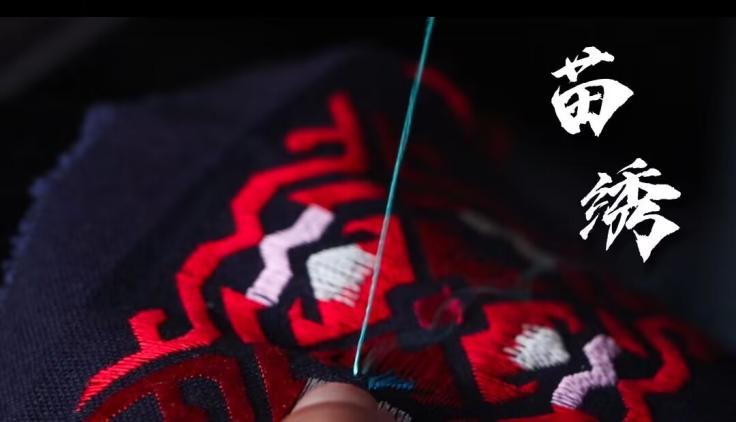 Bridging News
Bridging News
Audible | Pengshui Miao Embroidery: Ethnic Sentiments at Your Fingertips, Chinese Style Worldwide
Editor's Note: This article is produced in collaboration with the Chongqing Institute of Foreign Studies as part of a series of ongoing reports exploring the city's abundant resources in intangible cultural heritages.

Pengshui Miao embroidery. (Photo/Rongyu Miao Embroidery Crafts Development Co Ltd)
Every thread is painted, every stitch embroidered over a thousand years - Miao embroidery has truly become a medium for Miao ancestors to express their thoughts, depicting mountains, rivers, trees, and the ever-changing forms of nature on their spiritual journey of continuous migration.
"What is folk is also international." Miao embroidery has developed its own unique style and techniques through long-term evolution. On May 20, 2006, Miao embroidery was approved by the State Council and included in the first batch of national intangible cultural heritage lists. In 2016, Pengshui Miao embroidery skills were also recognized on the municipal "intangible heritage" list.
Pengshui Miao embroidery has a long history and intricate craftsmanship, renowned for its fine workmanship and meticulous techniques. It is not only a symbol of the Miao people's cultural heritage worn by women but also serves as an economic cornerstone for the villages' residents.
Using the needle as a pen, thread as ink, and cloth as paper, Miao embroidery is rich in stitches, each with its own characteristics. Pile embroidery, for example, forms shapes by folding small squares into triangles and stacking them, rather than using traditional needle and thread, resulting in abstract compositions of natural scenery that are both unique and universal.
Miao embroidery patterns are characterized by their simplicity, childlike quality, and vibrant colors, reflecting strong national characteristics. If you pay attention to observe, you will notice a wide variety of patterns in Miao embroidery, which integrates the colors of plants and trees into fabric, akin to wearing nature on the body. Pengshui Miao embroidery, exemplified by Puziba embroidery, features a range of colors and can be divided into monochrome embroidery, mainly in green thread with a simple technique known for its solemn elegance, and colored embroidery, using colorful threads inspired by flowers, birds, insects, fish, dragons, phoenixes, and unicorns in nature, resulting in vivid, colorful finished products.
In 2011, Chongqing Pengshui County Rongyu Miao Embroidery Crafts Development Co Ltd, under the leadership of Li Shaoyu, a deputy of the National People's Congress and an inheritor of intangible cultural heritage in Chongqing, undertook the mission of preserving heritage skills, expanding employment, and increasing income. The company organized local women left behind and low-income individuals to learn Miao embroidery, promoting employment and income through production.
For over a decade, Wang Guangrong and his wife, Li Shaoyu, have vigorously promoted Miao embroidery through university collaborations, competitions, and free teaching programs, encouraging participation by unemployed youth to foster greater appreciation for the art and breathe new life into its traditions.
Pengshui Miao embroidery is not only historical and national but also resonates with the times and the world. Through threaded needles, it births Miao history, transmits Miao emotions, and showcases ethnic sentiment and Chinese culture globally.
Chinese script: Fu HaiXia
Tutored by: Huang Xiying
Translation: Su Yi
Tutored by: Jiang Jun Huang Yan
Voice-over: Wang Hao
Tutored by: Ren Yi
 Related Stories
Related Stories